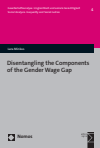Zusammenfassung
Das vorliegende Buch befasst sich mit den Komponenten und Triebkräften des geschlechtsspezifischen Lohngefälles, wobei der Untersuchungsschwerpunkt auf Deutschland liegt. Die vorgestellten Analysen gliedern sich in drei Teile, die jeweils einen Kernbereich beschreiben, der für die Aufrechterhaltung des Lohnabstandes von Bedeutung ist. Erstens wird untersucht, inwiefern sich radikale Veränderungen politischer und wirtschaftlicher Randbedingungen auf den geschlechtsspezifischen Lohnabstand auswirken. Zweitens wird die Bedeutung von Berufen für den Gender Pay Gap analysiert und drittens wird die Auswirkung von Diskriminierung im Zusammenhang mit geschlechtsstereotypisierten Soft Skills untersucht. Abschließend werden die wichtigsten Ergebnisse zusammengefasst und der weitere Forschungsbedarf diskutiert.
Abstract
This book examines the components of and driving forces behind the gender pay gap, focusing on Germany. It covers the historical significance and measurement of the gap and provides relevant theory and empirical evidence. It also explores three key areas, all related to the composition and forces that perpetuate the gender pay gap in today's labour markets. First, the impact of radical changes in political and economic institutions; second, the significance of occupations; and third, the impact of labour market discrimination and soft skills. The book concludes by summarising key findings, research needs and implications for the academic debate on this subject.
Schlagworte
discrimination Berufe economy Deutschland gender pay gap Diskriminierung Geschichte gender wage gap Germany Geschlechterlohnlücke Geschlechtslohnlücke history Lohngefälle occupations Lohnungleichheit soft skills wage inequality Soft-Skills Wirtschaft- 7–38 1. Introduction 7–38
- 127–130 5. Conclusion 127–130
- 131–132 Acknowledgements 131–132
- 133–146 References 133–146
- 147–150 Appendix 147–150

